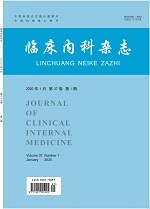Journal of clinical internal medicine
2019, 36 (11):
748-750.
DOI: 10.3969/j.issn.1001-9057.2019.11.010
Objective To explore the effects of hemodialysis and peritoneal dialysis on microinflammation of chronic renal failure(CRF)uremic patients and its relationship with cardiovascular disease.Methods A total of 120 CRF uremic patients treated in our hospital were divided into hemodialysis group(60 cases) and peritonealdialysis group(60 cases) according to the type of dialysis.After 6 months of treatment,the levels of C reactive protein(CRP),tumor necrosis factor(TNF)-α,interleukin(IL)-1β,IL-6 btween the two groups were compared.Patients in the two groups were divided into the group with and without chronic heart failure(CHF) according to the presence or absence of combined with CHF,the levels of TNF-α、IL-1β,IL-6 in each group were compared.Results There were no significant differences in the levels of CRP,TNF-α,IL-1β,IL-6 between the two groups before treatment(P>0.05).After treatment,the levels of TNF-α,IL-1β,IL-6 in both groups were significantly reduced than the same group before treatment(P<0.05),the levels of TNF-α,IL-1β,IL-6 in the peritoneal dialysis group were lower than those in the hemodialysis group(P<0.05).In patients with CHF,the levels of TNF-α,IL-1β,IL-6 in patients of the group with heart failure were significantly higher than those in the same group of the group without heart failure(P<0.05).Conclusion Both hemodialysis and peritoneal dialysis can reduce the level of TNF-α,IL-1β,IL-6 in CRF uremic patients,and peritoneal dialysis is better.Microinflammation is correlated with cardiovascular disease.








